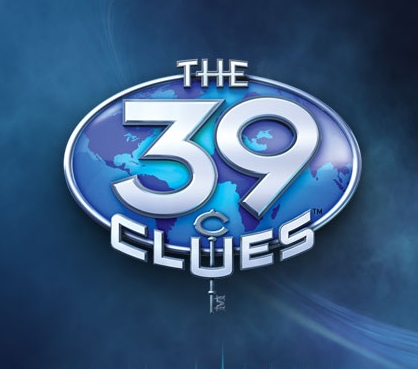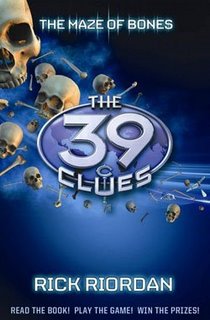Once upon a time, there was only one way for children to dive into worlds of wonder, magic, and fantasy, and that was to read books. The beloved tales of The Lord of the Rings, The Chronicles of Narnia, and The Golden Compass brought hobbits, witches, and dæmons off the page and into millions of children’s imaginations. These popular childhood adventure novels, once intended to be pure literary works, now exist as major multi-platform franchises, spanning films, videogames, web pages, social networks, fan fiction, mobile content, and merchandise.
In the digital age, our youth has come to expect these kinds of multimedia dimensions out of their favorite books, especially on the Internet, and publishing companies have noticed. On September 9th, Scholastic Media will release The Maze of Bones, the first installment of the highly anticipated “The 39 Clues.”
The series is Scholastic’s follow up to the mega hit Harry Potter. Except, unlike Harry Potter, which evolved into a transmedia powerhouse after the books’ rising popularity, The 39 Clues will be a massive multiplatform adventure right from the get-go. In fact, on Scholastic’s homepage a message appears next to The Maze of Bones: “WARNING: This book could take over your life!”
Aimed at kids ages 8-12, The 39 Clues will be a 10 book series with a single story arc. It will be released over two years with each book written by a different best selling author. The franchise will be about uncovering the secrets of the most powerful family in the world, the Cahills, of which Benjamin Franklin, Mozart, Napoleon and Houdini are relatives. It all begins when the Cahill clan matriarch, Grace, changes her will five minutes before she dies, giving her descendants the choice between $1 million or a clue. Amy, 14, and Dan, 11, the series protagonists, are two young Cahills who must compete with other branches of the family to uncover the 39 clues and discover the family’s ultimate power.
Here’s an excerpt from Rick Riordan’s The Maze of Bones (you can read the first two chapters online here):
“The children are old enough. They are our only chance,” Grace said to William, her attorney and closest friend for half her life. “If they don’t succeed, 500 years of work will have been for nothing.” And with that final statement, Grace Cahill closed her eyes for the last time.
On Sept 9, when 500,000 prints of The Maze of Bones hit bookstores simultaneously in the U.S., U.K., Australia, New Zealand and Canada, the official online interactive game will launch as well. This multimillion dollar marketing campaign features a contest where kids will follow the clues and hunt for answers. Scholastic promises more than $100,000 in prizes during the duration of the series. And participants who find all 39 clues and uncover the Cahill treasure will compete for the $10,000 grand prize.
To assist kids on this epic scavenger hunt, Scholastic will offer hundreds of collectible game cards as well as websites containing thousands of pages of background information, blogs written by characters in the story, online games, maps, treasure hunts, and numerous geographical and historical videos. Needless to say, this will be a much different childhood story than Nancy Drew.
Remember when it took decades for the most popular childhood adventure stories to successfully hit the big screen? (Lord of the Rings, Chronicles of Narnia) Over the last decade, technological advances have made it possible to bring classic children’s novels to life with stunning visuals. Now children’s series become film adaptations before anyone has time to finish reading the books. Sure enough, before The 39 Clues could hit bookstores, Dreamworks acquired the film rights, signing Jeff Nathanson (The Terminal, Catch Me If You Can, Indiana Jones 4) to write the first installment and possibly Steven Spielberg to direct it.
Spielberg told Variety in a statement that The 39 Clues takes “creative leaps to expand the story experience from the pages of the books to multiple stages of discovery and imagination.”
It seems as if the future of children’s publishing is headed towards multiplatform experiences. And Scholastic isn’t the only company hoping to cash in on the trend. Fourth Story Media has teamed up with HarperCollins to launch the The Amanda Project, an interactive mystery series targeted at girls ages 12 to 14 that is told across books, web sites, social networks, and blogs. CSI creator Anthony Zuiker has signed a deal with Dutton, a division of Penguin Group (USA), to write “digital novels” in addition to an interactive Web site. And Simon & Schuster will release “Spaceheadz,” a series of books coauthored by Jon Scieszka and Francesco Sedita which also relies heavily on Internet sites.
Sciezka, the National Ambassador of Young People’s Literature, told CNN in this article:
“In the past we’ve made the mistake of demonizing other media, saying all TV is bad, all computers are bad, and all books are good. Kids know that it’s not true; there is great television and there are great games. I just also want to make sure that we don’t forget what’s unique about a book, losing yourself in an extended narrative.”
The question is, does transmedia storytelling encourage children to read books? Rick Riordan thinks so. He’s crafted the narrative in The Maze of Bones to stand on its own while also recognizing that the complimentary game helps to expand the expierence. As a result, Riordan hopes to attract both readers and gamers. As he points out in this New York Times article:
There’s a lot of commonality between what makes a good game and a good book. Whether you’re a gamer or a reader, you want to feel immersed in the story and invested in the action and the characters, and you want to care about the outcome and you want to participate in solving the mystery.
Some kids are always going to prefer games over books. But if you can even reach a few of those kids and give them an experience with a novel that makes them think, ‘Hey, reading can be another way to have an adventure,’ then that’s great. Then I’ve done my job.
Riordan’s comments highlight a fundamental change in the way children engage with fictional universes. Increasingly, children immerse themselves in literary stories not only by mentally constructing how characters and events might look but now also by interacting and participating with them. At times, they are hunters and gatherers in an effort to expand their understanding of the world, other times they are directly contributing to it. Children have taken a much more involved, community driven role, thanks to the Internet. Without a doubt, transmedia storytelling is revolutionizing children’s imaginations, redefining how they access storyworlds and how they interact with them.
Yet the Huffington Post asks an important question, “can a phenomenon be conceived by a publisher rather than created by the public?” Manufacturing a Harry Potter-type blockbuster is an enormous risk. Although, one could argue that the 39 Clues is more like a kid’s ARG than a literary series. Each book will come with six collectors’ cards that can be used to find further clues in the online game. Now we don’t know how prominent a role the contest will play in the franchise, but clearly Scholastic assumes their multiplatform approach will be a mega-hit. And if it is, how much of that success will have to do with the gaming and prize components? I mean, even The Maze of Bones’ cover instructs us to “Read the book. Play the game. Win the prizes.” That should almost be followed by “See the movie. Buy the merchandise. Make us rich.”
Is that what it takes to get kids to read? Do children really need a more involved, active experience in their literature, or is that just something publishing houses say in order to make the big bucks? How has multiplatform entertainment changed the role of the novel? Does it make kids more eager to participate in someone else’s storyworld (the publisher’s) rather than creating their own?
There are many more questions than answers when it comes to The 39 Clues. But I am excited to see how the franchise develops. I will be following the clues, not just in the context of the story, but also in observing how transmedia storytelling affects the children story experience. This could very well be the next Harry Potter, but whether that is decided by the publishers or the fans remains to be seen.
Note:
Just to be clear, Rick Riordan has clarified this on his blog, The 39 Clues has no magical or fantastical elements. It is a realistic adventure, though it holds plenty of mystery and wonder.
Here’s Riordan explaining the series:




